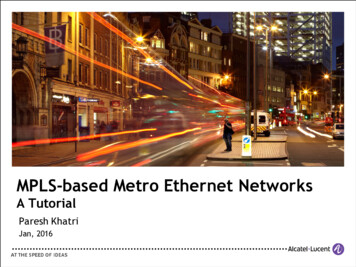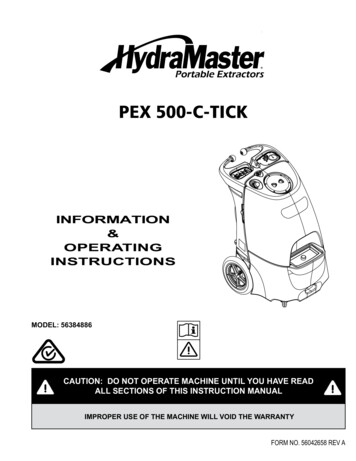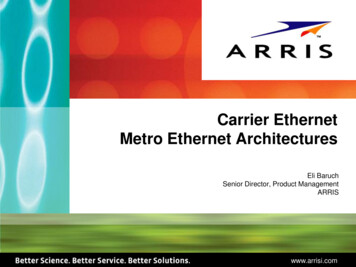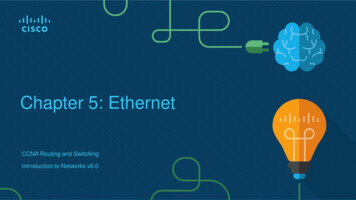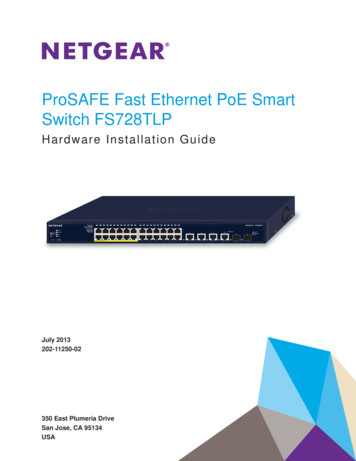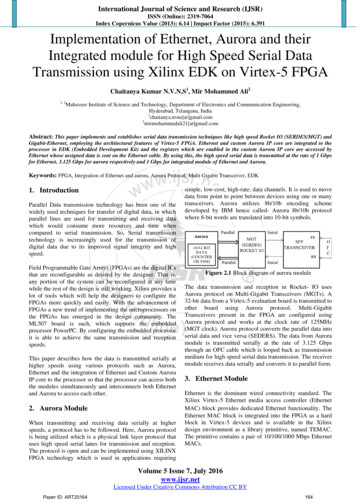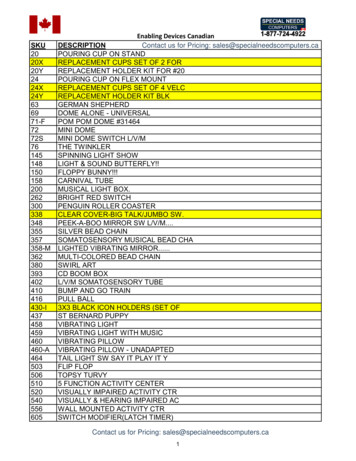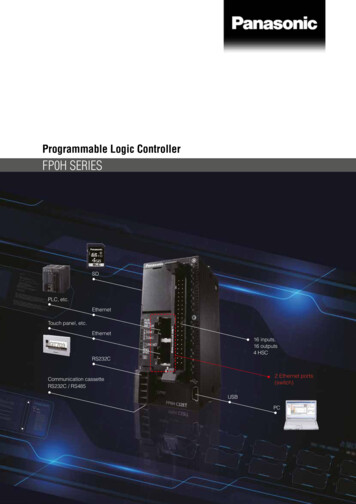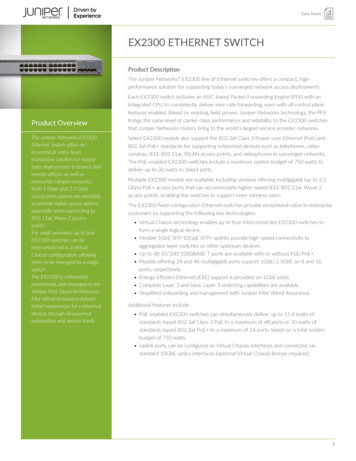
Transcription
Data SheetEX2300 ETHERNET SWITCHProduct DescriptionThe Juniper Networks EX2300 line of Ethernet switches offers a compact, highperformance solution for supporting today’s converged network access deployments.Product OverviewThe Juniper Networks EX2300Ethernet Switch offers aneconomical, entry-level,standalone solution for accesslayer deployments in branch andremote offices, as well asenterprise campus networks.Both 1 Gbps and 2.5 Gbpsaccess port options are availableto provide higher-speed options,especially when connecting to802.11ac Wave 2 accesspoints.For small networks, up to fourEX2300 switches can beinterconnected in a VirtualChassis configuration, allowingthem to be managed as a singleswitch.The EX2300 is onboarded,provisioned, and managed in theJuniper Mist Cloud Architecture.Mist Wired Assurance deliversbetter experiences for connecteddevices through AI-poweredautomation and service levels.Each EX2300 switch includes an ASIC-based Packet Forwarding Engine (PFE) with anintegrated CPU to consistently deliver wire-rate forwarding, even with all control planefeatures enabled. Based on existing, field-proven Juniper Networks technology, the PFEbrings the same level of carrier-class performance and reliability to the EX2300 switchesthat Juniper Networks routers bring to the world’s largest service provider networks.Select EX2300 models also support the 802.3af Class 3 Power over Ethernet (PoE) and802.3at PoE standards for supporting networked devices such as telephones, videocameras, IEEE 802.11ac WLAN access points, and videophones in converged networks.The PoE-enabled EX2300 switches include a maximum system budget of 750 watts todeliver up to 30 watts to select ports.Multiple EX2300 models are available, including versions offering multigigabit (up to 2.5Gbps) PoE access ports that can accommodate higher-speed IEEE 802.11ac Wave 2access points, enabling the switches to support more wireless users.The EX2300 fixed-configuration Ethernet switches provide exceptional value to enterprisecustomers by supporting the following key technologies: Virtual Chassis technology enables up to four interconnected EX2300 switches toform a single logical device. Flexible 1GbE SFP/10GbE SFP uplinks provide high-speed connectivity toaggregation layer switches or other upstream devices. Up to 48 10/100/1000BASE-T ports are available with or without PoE/PoE . Models offering 24 and 48 multigigabit ports support 1GbE/2.5GbE on 8 and 16ports, respectively Energy Efficient Ethernet (EEE) support is provided on 1GbE ports. Complete Layer 2 and basic Layer 3 switching capabilities are available. Simplified onboarding and management with Juniper Mist Wired Assurance.Additional features include: PoE-enabled EX2300 switches can simultaneously deliver up to 15.4 watts ofstandards-based 802.3af Class 3 PoE to a maximum of 48 ports or 30 watts ofstandards-based 802.3at PoE to a maximum of 24 ports, based on a total systembudget of 750 watts. Uplink ports can be configured as Virtual Chassis interfaces and connected viastandard 10GbE optics interfaces (optional Virtual Chassis license required).1
EX2300 Ethernet Switch Fixed power supply and uplink ports ensure operationalsimplicity. Low power consumption, low acoustic fans, and a small 10inch deep footprint enable flexible, environmentally friendlydeployment. Support for L2 protocols as well as L3 protocols like RIP andstatic routing are included in the base license. Support is available for IPv6 management, including neighbordiscovery, telnet, SSH, DNS, system log, and NTP. A single release train for Juniper Networks Junos operatingsystem is supported to ensure a consistent control planefeature implementation. Modular Junos OS prevents a switch reboot if a single protocolfeature fails. Built-in Web interface (Juniper Networks J-Web Software) isprovided. RJ-45 serial console port is available. USB mini console port is included on 1GbE access switchmodels. Out-of-band Ethernet management port is provided. Reduction of Hazardous Waste (RoHS) is certified.Architecture and Key ComponentsThe EX2300 occupies a single rack unit, delivering a compactsolution for crowded wiring closets and access locations wherespace and power are at a premium. The EX2300 switch’s 10inch/12-inch depth and low acoustics also make it ideal for openoffice deployments. For silent operation requirements, please seethe EX2300-C, a c ompact, fanless version of the EX2300.Cloud Management with Juniper Mist Wired AssuranceJuniper Mist Wired Assurance, a cloud-based service driven by MistAI to claim, configure, manage, and troubleshoot the EX2300,delivers AI-powered automation and service levels to ensure abetter experience for connected devices. Wired Assuranceleverages rich Junos switch telemetry data to simplify operations,reduce mean time to repair, and improve visibility. Wired Assuranceoffers the following features: Day 0 operations—Onboard switches seamlessly by claiming agreenfield switch or adopting a brownfield switch with a singleactivation code for true plug-and-play simplicity. Day 1 operations—Implement a template-based configurationmodel for bulk rollouts of traditional and campus fabricdeployments, while retaining the flexibility and control requiredto apply custom site- or switch-specific attributes. Automateprovisioning of ports via Dynamic Port Profiles. Day 2 operations—Leverage the AI in Juniper Mist WiredAssurance to meet service-level expectations such asthroughput, successful connects, and switch health with keypre- and post-connection metrics (see Figure 1). Add the selfdriving capabilities in Marvis Actions to detect loops, addmissing VLANs, fix misconfigured ports, identify bad cables,isolate flapping ports, and discover persistently failing clients(see Figure 2). And perform software upgrades easily throughJuniper Mist cloud.Each EX2300 switch supports four fixed front-panel 1GbE/10GbEuplink ports (six 1/10GbE uplink ports on the 48-port multigigabitmodel) with pluggable optics (purchased separately) for high-speedbackbone or link aggregation connections between wiring closetsand upstream aggregation switches. The 1GbE EX2300 accessswitch models also feature a front-panel mode button that offers asimple interface for bringing devices up and selecting LED modes.A dedicated rear panel RJ-45 Ethernet port is available for outofband management, while a rear panel USB port can be used toFigure 1: Juniper Mist Wired Assurance service-level expectationseasily upload the Junos OS and configuration files.Figure 2: Marvis Actions for wired switches2
EX2300 Ethernet SwitchThe addition of Marvis, a complementary Virtual Network Assistantdriven by Mist AI, lets you start building a self-driving network thatsimplifies network operations and streamlines troubleshooting viaautomatic fixes for EX Series switches or recommended actions forexternal systems.For more information see Juniper Mist Wired Assurance.Virtual Chassis TechnologyThe EX2300 supports Juniper’s unique Virtual Chassis technology,enabling up to four interconnected EX2300 switches to bemanaged as a single logical device, delivering a scalable, pay-as-yougrow solution for expanding network environments.While EX2300 switches can be interconnected over any of thefront-panel uplink ports using standard 10GbE SFP transceivers(sold separately), these ports can also be configured as 1GbE/10GbE uplinks to aggregation devices by disabling the VirtualChassis technology.When deployed in a Virtual Chassis configuration, the EX2300switches elect a primary and a backup switch based on a set ofpreconfigured policies or criteria. The primary switch automaticallycreates and updates the switching and optional routing tables on allother Virtual Chassis switch members. Switches can be added to orremoved from the Virtual Chassis configuration without servicedisruption.EX2300 Virtual Chassis configurations operate as highly resilientunified systems, providing simplified management using a single IPaddress, single telnet session, single command-line interface (CLI),automatic version checking, and automatic configuration. TheEX2300 switches are also capable of local switching, so packetscoming into a port destined for another port on the same switch donot have to traverse the Virtual Chassis, increasing forwardingcapacities.EX2300 Virtual Chassis configurations implement the same slot/module/port numbering schema as other Juniper Networks chassisbased products, providing true chassis-like operations. By using aconsistent operating system and a single configuration file, allswitches in a Virtual Chassis configuration are treated as a singledevice, simplifying overall system maintenance and management.Multigigabit SwitchesIEEE 802.11ac Wave 2 access points require switch ports capableof handling up to 2.5 Gbps in order to support the growing numberof wireless devices and the amount of traffic they produce. Toaddress this need, specific multigigabit EX2300 models now offer 1Gbps and 2.5 Gbps access ports to support these increasedbandwidth requirements over existing Category 5e cabling. Theseswitches run the same Junos image and support all the samesoftware features as other EX2300 models.The EX2300 multigigabit switches can interoperate with other EXSeries switches in Virtual Chassis deployments, protecting existingcustomer investments by enabling them to add multigigabit supportto their existing Juniper network deployments.The EX2300 multigigabit switches support PoE on all access ports,provided the power demand is within the PoE budget.Table 1: EX2300 multigigabit switchesModel1 Gbps Ports1/2.5 GbpsPortsPoE/ PoE Uplinks Fans Air FlowEX2300- 24MP8-230-7All access ports 4 SFP 3Side-sideEX2300- 48MP0-15; 32-4716-31All access ports 6 SFP 4Side-sideFigure 3: EX2300 switches support Virtual Chassis technology, which enables up to four interconnected switches to operate as a single, logical device.3
EX2300 Ethernet SwitchVirtual Chassis technology simplifies network management forsmaller deployments. Up to four interconnected EX2300 switchescan be managed as a single device utilizing a single Junos OS imageand a single configuration file, reducing the overall number of unitsto monitor and manage. When the Junos OS is upgraded on theprimary switch in an EX2300 Virtual Chassis configuration, thesoftware is automatically upgraded on all other member switches atthe same time.The EX2300 includes port profiles that allow networkadministrators to automatically configure ports with security, QoS,and other parameters based on the type of device connected to theport. Six preconfigured profiles are available, including default,desktop, desktop plus IP phone, WLAN access point, routed uplink,and Layer 2 uplink. Users can select from the existing profiles orcreate their own and apply them through the command-lineinterface (CLI), J-Web Software interface, or management system.In addition, a feature called system snapshot makes a copy of allsoftware files used to run the switch—including the Junos operatingsystem, the active configuration, and the rescue configuration.These files can be used to reboot the switch at the next power-upor as a backup boot option. The Junos OS software can also bepreinstalled on a flash drive and used to boot the EX2300 at anytime.Campus Fabric DeploymentsJuniper campus fabrics support these validated architectures withthe EX2300 switch playing the role of access switch in a VirtualChassis: EVPN multihoming (collapsed core or distribution): Acollapsed core architecture combines the core and distributionlayers into a single switch, turning the traditional three-tierhierarchal network into a two-tier network. This eliminates theneed for STP across the campus network by providingmultihoming capabilities from the access to the core layer.EVPN multihoming can be deployed and managed using theJuniper Mist cloud. Core-Distribution: A pair of interconnected EX Series core ordistribution switches provide L2 EVPN and L3 VXLAN gatewaysupport. The EVPN-VXLAN network between the distributionand core layers offers two modes: centrally or edge routedbridging overlay.In all these EVPN-VXLAN deployment modes, EX2300 switchescan be used in Virtual Chassis configurations.Another feature, called automatic software download, enablesnetwork administrators to easily upgrade the EX2300 using theDHCP message exchange process to download and install softwarepackages. Users simply configure the automatic software downloadfeature on EX2300 switches acting as DHCP clients and establish apath to the server where the software package file is installed. Theserver then communicates the path to the software package filethrough DHCP server messages.The ZTP feature allows a DHCP server to push configuration detailsand software images to multiple switches at boot-up time.Figure 4: Campus fabrics showing Virtual Chassis and EVPN-VXLAN-based architectures4
EX2300 Ethernet SwitchFeatures and BenefitsJunos Operating SystemManaging AI-Driven Campus Fabric with the Juniper Mist CloudThe EX2300 switches run the same Junos OS that is used by otherJuniper Networks EX Series Ethernet Switches, QFX SeriesSwitches, Juniper Routers, Juniper SRX Firewalls, and the JuniperNFX Series Network Services Platform. By utilizing a commonoperating system, Juniper delivers a consistent implementation andoperation of control plane features across all products. To maintainthat consistency, the Junos OS adheres to a highly disciplineddevelopment process that uses a single source code, and it employsa highly available modular architecture that prevents isolatedfailures from bringing down an entire system.Juniper Mist Wired Assurance brings cloud management and MistAI to campus fabric. It sets a new standard moving away fromtraditional network management towards AI-driven operations,while delivering better experiences to connected devices. TheJuniper Mist Cloud streamlines deployment and management ofcampus fabric architectures by allowing: Automated deployment and zero touch deployment Anomaly detection Root cause analysisThese attributes are fundamental to the core value of the software,enabling all Junos OS-powered products to be updatedsimultaneously with the same software release. All features are fullyregression-tested, making each new release a true superset of theprevious version. Customers can deploy the software withcomplete confidence that all existing capabilities are maintained andoperate in the same way.Converged EnvironmentsFigure 5. EVPN multihoming configuration via the Juniper Mist cloudHigh Availability FeaturesTo avoid the complexities of the Spanning Tree Protocol (STP)without sacrificing network resiliency, the EX2300 employs aredundant trunk group (RTG) to provide the necessary portredundancy and simplify switch configuration. It also supportscross-member link aggregation, which allows redundant linkaggregation connections between devices in a single Virtual Chassisconfiguration, providing an additional level of reliability andavailability.The EX2300 provides the highest levels of flexibility and features inits class for the most demanding converged data, voice, and videoenvironments, delivering a reliable platform for unifying enterprisecommunications.By providing a full 15.4 watts of Class 3 PoE to VoIP telephones,closed-circuit security cameras, wireless access points, and other IPenabled devices, the EX2300 delivers a future-proofed solution forconverging disparate networks onto a single IP infrastructure. TheEX2300 PoE switches also support 802.3at standards-based PoE ,delivering 30 watts for powering networked devices such as IEEE802.11ac wireless access points, and videophones that mightrequire more power than available with IEEE 802.3af.To ease deployment, the EX2300 supports the industrystandardLink Layer Discovery Protocol (LLDP) and LLDPMedia EndpointDiscovery (LLDP-MED) protocol, enabling the switches toautomatically discover Ethernet-enabled devices, determine theirpower requirements, and assign virtual LAN (VLAN) membership.LLDP-MED-based granular PoE management allows the EX2300 tonegotiate PoE usage down to a fraction of a watt on powereddevices, enabling more efficient PoE utilization across the switch.In addition, the EX2300 supports rich quality-of-service (QoS)functionality for prioritizing data, voice, and video traffic. Theswitches support eight class-of-service (CoS) queues on every port,enabling them to maintain multilevel, end-to-end trafficprioritizations. The EX2300 also supports a wide range of policyoptions, including strict priority, low latency, weighted random earlydetection (WRED), and shaped-deficit weighted roundrobin(SDWRR) queuing.5
EX2300 Ethernet SwitchSecurityWorking as an enforcement point in Access Policy Infrastructure,the EX2300 provides both standards-based 802.1X portlevelaccess control for multiple devices per port, as well as Layer 2-4policy enforcement based on user identity, location, device, or acombination of these. A user’s identity, device type, machineposture check, and location can be used to determine whetheraccess should be granted and for how long. If access is granted, theswitch provides access to the network based on authorizationattributes sent by the authentication server. The switch can alsoapply security policies, QoS policies, or both, or it can mirror usertraffic to a central location for logging, monitoring, or threatdetection by intrusion prevention systems.The EX2300 also provides a full complement of integrated portsecurity and threat detection features, including Dynamic HostConfiguration Protocol (DHCP) snooping, dynamic ARP inspection(DAI), and media access control (MAC) limiting to defend againstinternal and external spoofing, and man-in-themiddle and denial ofservice (DoS) attacks.Flex LicensingJuniper Flex licensing offers a common, simple, and flexiblelicensing model for EX Series access switches, enabling customersto purchase features based on their network and business needs.The EX2300 switches support both subscription and perpetual Flexlicenses. Subscription licenses are offered for three- and five-yearterms. In addition to Junos features, the Flex Advanced andPremium subscription licenses include Juniper Mist WiredAssurance. Flex Advanced and Premium subscription licenses alsoallow portability across the same tier and class of switches, ensuringinvestment protection for the customer.For a complete list of features supported by the Flex Standard,Advanced, and Premium tiers, or to learn more about Junos EXSeries licenses, please visit for-ex.htmlEnhanced Limited Lifetime WarrantyThe EX2300 includes an enhanced limited lifetime hardwarewarranty that provides return-to-factory switch replacement for aslong as the original purchaser owns the product. The warrantyincludes lifetime software updates, advanced shipping of spareswithin one business day, and 24x7 Juniper Networks TechnicalAssistance Center (JTAC) support for 90 days after the purchasedate. Power supplies and fan trays are covered for a period of fiveyears. For complete details, please visit https://support.juniper.net/support/Flex licensing is offered in Standard, Advanced, and Premium tiers.Standard tier features are available with the Junos OS image thatships with EX Series switches. Additional features can be unlockedwith the purchase of a Flex Advanced or Flex Premium license.The Flex Advanced and Premium licenses for the EX Seriesplatforms are class based, determined by the number of accessports on the switch. Class 1 (C1) switches have 12 ports, Class 2(C2) switches have 24 Ports, and Class 3 (C3) switches have 32 or48 Ports.6
EX2300 Ethernet SwitchPhysical SpecificationsCoolingPower OptionsModelMax. System Power Consumption (InputPower without PoE)Total PoE Power Budget Airflow:- EX2300-24T: 25 cfm- EX2300-24P: 23 cfm- EX2300-48T: 24 cfm- EX2300-48P: 25 cfmEX2300-24T55 W AC0EX2300-24P80 W AC370 WEX2300-24MP55 W AC380 WEX2300-48T70 W AC0EX2300-48P100 W AC750 WHardware SpecificationsEX2300-48MP90 W AC750 WSwitching Engine ModelDimensions (W x H x D) Width:- 17.4 in (44.19 cm) for desktop installations- 17.5 in (44.6 cm) with rack-mount brackets Height: 1.75 in (4.45 cm) for 1U installations Depth:- EX2300-24T: 10.2 in (25.9 cm)- EX2300-24P: 12.2 in (30.98 cm)-EX2300-24MP: 10 in (25.4 cm)EX2300-48T: 10.2 in (25.9 cm)EX2300-48P: 12.2 in (30.98 cm)EX2300-48MP: 14.5 in (36.83 cm)Backplane 80 Gbps Virtual Chassis interconnect to link up to fourswitches as a single logical device (EX2300-24/48T/P andEX2300-24/48 MP models)System Weight EX2300-24T: 7.25 lb (3.29 kg)EX2300-24P: 9.89 lb (4.49 kg)EX2300-24MP: 8.82 lb (4 kg)EX2300-48T: 8.29 lb (3.76 kg)EX2300-48P: 11.07 lb (5.02 kg)EX2300-48MP: 14.33 lb (6.5 kg)Environmental Ranges Operating temperature: 32 to 113 F (0 to 45 C) Storage temperature: -40 to 158 F (-40 to 70 C) Operating altitude: up to 13,000 ft (3962 m) at 40 Caccording to GR-63 Non-operating altitude: up to 15,000 ft (4572 m) Relative humidity operating: 10% to 85% (noncondensing) Relative humidity non-operating: 0% to 95% (noncondensing) Store and forwardDRAM 2 GB (EX2300-24/48T/P)Flash 2 GB (EX2300 non-multigigabit models) 8 GB (EX2300-24MP, EX2300-48MP)CPU 1.25GHz ARM CPUGbE Port Density per System EX2300-24P/24T/24MP: 28 (24 host ports four-portSFP/SFP uplinks) EX2300-48P/48T: 52 (48 host ports four-port SFP/SFP uplinks) EX2300-48MP: 54 (48 host ports six-port SFP/SFP uplinks)Supported Optics 10/100/1000BASE-T connector type RJ-45 GbE SFP optic/connector type: RJ-45, or LC SFP fibersupporting 1000BASE-T SFP, SX (multimode), LX (singlemode),or LH (single-mode)Physical Layer Physical port redundancy: Redundant trunk group (RTG) Cable diagnostics for detecting cable breaks and shorts Auto MDI/MDIX (medium-dependent interface/mediumdependent interface crossover) support Port speed downshift/setting maximum advertised speed on10/100/1000BASE-T ports Digital optical monitoring for optical portsPacket-Switching Capacities (Maximum with 64-Byte Packets) EX2300-24P/24T: 64 Gbps (unidirectional)/128 Gbps(bidirectional) EX2300-24MP: 76 Gbps (unidirectional)/ 152 Gbps(bidirectional)7
EX2300 Ethernet Switch EX2300-48P/48T: 88 Gbps (unidirectional)/176 Gbps(bidirectional) EX2300-48MP: 132 Gbps (unidirectional)/264 Gbps(bidirectional)Software SpecificationsLayer 2/Layer 3 Throughput (Mpps) (Maximum with 64 BytePackets) EX2300-24P/24T/24MP: 95 Mpps (wire speed) EX2300-48P/48T/48MP: 130 Mpps (wire speed)Layer 2 Features Maximum MAC addresses in hardware: 16,000Jumbo frames: 9216 bytesNumber of VLANs supported: 4093 (2044 active VLAN)Range of possible VLAN IDs: 1-4094Port-based VLANMAC-based VLANVoice VLANLayer 2 Protocol Tunneling (L2PT) IEEE 802.1ak: Multiple VLAN Registration Protocol (MVRP)Compatible with Per-VLAN Spanning Tree Plus (PVST )RVI (Routed VLAN Interface)IEEE 802.1AB: Link Layer Discovery Protocol (LLDP)LLDP-MED with VoIP integrationIEEE 802.1ad Q-in-Q tunnelingIEEE 802.1br: Bridge Port ExtensionIEEE 802.1D: Spanning Tree ProtocolIEEE 802.1p: CoS PrioritizationIEEE 802.1Q: VLAN TaggingIEEE 802.1Q-in-Q: VLAN StackingIEEE 802.1s: Multiple Spanning Tree Protocol (MSTP)Number of MST instances supported: 64Number of VSTP instances supported: 253IEEE 802.1w: Rapid Spanning Tree Protocol (RSTP)IEEE 802.1X: Port Access ControlIEEE 802.3: 10BASE-TIEEE 802.3u: 100BASE-TIEEE 802.3ab: 1000BASE-T IEEE 802.3z: 1000BASE-XIEEE 802.3af: PoEIEEE 802.3at: PoE IEEE 802.3ad: Link Aggregation Control Protocol (LACP)IEEE 802.3x: Pause Frames/Flow ControlIEEE 802.3az: Energy Efficient EthernetLayer 3 Features: IPv4 Maximum number of ARP entries: 1,500 Maximum number of IPv4 unicast routes in hardware: 512prefixes; 4,096 host routes Maximum number of IPv4 multicast routes in hardware: 2,048groups; 2,048 multicast routes Routing Protocols: RIP v1/v2, OSPF v1/v2 Static routing Routing policy Bidirectional Forwarding Detection (BFD) with slow timers ( 3sec) IP directed broadcastLayer 3 Features: IPv6 Maximum number of Neighbor Discovery (ND) entries: 1,500 Maximum number of IPv6 unicast routes in hardware: 512prefixes; 2,048 host routes Maximum number of IPv6 multicast routes in hardware: 1,024groups; 1,024 multicast routes Neighbor discovery, system logging, Telnet, SSH, SNMP,Network Time Protocol (NTP), Domain Name System (DNS) Static routing Routing protocols: RIPng, OSPF v3, Multicast ListenerDiscovery, Multicast Listener Discovery v2Access Control Lists (ACLs) (Junos OS Firewall Filters) Port-based ACL (PACL)—256 ingress; 256 egressVLAN-based ACL (VACL)— 256 ingress; 256 egressRouter-based ACL (RACL)—256 ingress; 512 egressACL entries (ACE) in hardware per system: 2,000ACL counter for denied packetsACL counter for permitted packetsAbility to add/remove/change ACL entries in middle of list(ACL editing) L2-L4 ACLAccess Security MAC limitingAllowed MAC addresses—configurable per portSticky MAC (persistent MAC address learning)Dynamic ARP inspection (DAI)Proxy ARPStatic ARP supportDHCP snooping802.1X port-based802.1X multiple supplicants802.1X with VLAN assignment802.1X with authentication bypass access (based on host MACaddress)8
EX2300 Ethernet Switch 802.1X with VoIP VLAN support 802.1X dynamic ACL based on RADIUS attributes 802.1X Supported EAP types: Message Digest 5 (MD5),Transport Layer Security (TLS), Tunneled Transport LayerSecurity (TTLS), Protected Extensible Authentication Protocol(PEAP) IPv6 RA Guard IPv6 Neighbor Discovery Inspection Captive Portal Static MAC authentication MAC-RADIUS Control plane DoS protection Fallback authentication Trusted Network Connect (TNC) certifiedHigh Availability Link aggregation 802.3ad (LACP) support:- Number of LAGs supported: 128- Maximum number of ports per LAG: 8 Tagged ports support in LAG Uplink Failure DetectionQuality of Service (QoS) Layer 2 QoS Layer 3 QoS Ingress policing: one-rate two-color; two-rate three-colormarkers Hardware queues per port: 8 Scheduling methods (egress): Strict Priority (SP), shapeddeficitweighted round-robin (SDWRR) 802.1p, DSCP /IP precedence trust and marking L2-L4 classification criteria: Interface, MAC address, EtherType,802.1p, VLAN, IP address, DSCP/IP precedence, TCP/UDPport numbers Congestion avoidance capabilities: Tail drop and WREDMulticast IGMP snooping entries: 2,000IGMP: v1, v2, v3IGMP snoopingPIM-SM, PIM-SSM, PIM-DMMLD snoopingManagement and Analytics Platforms Juniper Mist Wired Assurance for Campus Junos Space Network Director for Campus Junos Space ManagementDevice Management and Operations Junos OS CLI Junos Web interface (J-Web) Out-of-band management: Serial, 10/100BASE-T Ethernet ASCII configurationRescue configurationConfiguration rollbackImage rollbackSimple Network Management Protocol (SNMP): v1, v2c, v3Remote monitoring (RMON) (RFC 2819) Groups 1, 2, 3, 9Network Time Protocol (NTP)DHCP serverDHCP client and DHCP proxyDHCP relay and helperRADIUS authenticationTACACS authenticationSSHv2Secure copyHTTP/HTTPs DNS resolverSystem log loggingTemperature sensorConfiguration backup via FTP/secure copyInterface rangeSupported RFCs RFC 768 UDPRFC 783 Trivial File Transfer Protocol (TFTP)RFC 791 IPRFC 792 Internet Control Message Protocol (ICMP)RFC 793 TCPRFC 826 ARPRFC 854 Telnet client and serverRFC 894 IP over EthernetRFC 903 Reverse ARP (RARP)RFC 906 Bootstrap Loading using TFTPRFC 951, 1542 BootPRFC 1027 Proxy ARPRFC 1058 RIP v1RFC 1122 Requirements for Internet HostsRFC 1256 IPv4 ICMP Router Discovery (IRDP)RFC 1492 TACACS RFC 1519 Classless Interdomain Routing (CIDR)RFC 1591 Domain Name System (DNS)RFC 1812 Requirements for IP Version 4 routersRFC 2030 Simple Network Time Protocol (SNTP)RFC 2068 HTTP/1.1RFC 2131 BOOTP/DHCP relay agent and DHCP server9
EX2300 Ethernet Switch RFC 2138 RADIUS Authentication RFC 2139 RADIUS Accounting RFC 2863 The Interfaces Group MIB RFC 2922 LLDP MIB RFC 2925 Definitions of Managed Objects for Remote Ping,Traceroute, and Lookup Operations RFC 3413 SNMP Application MIB RFC 3414 User-based Security Model for SNMPv3 RFC 3415 View-based Access Control Model (VACM) forSNMP RFC 3484 Default Address Selection for IPv6 RFC 3621 PoE-MIB (PoE switches only) RFC 3810 Multicast Listener Discovery Version 2 (MLDv2) forIPv6 RFC 4188 STP and Extensions MIB RFC 4213 Basic Transition Mechanisms for IPv6 Hosts andRouters RFC 4291 IPv6 Addressing Architecture RFC 4363 Definitions of Managed Objects for Bridges withTraffic Classes, Multicast Filtering, and VLAN Extensions RFC 4443 ICMPv6 for the IPv6 Specification RFC 4861 Neighbor Discovery for IPv6 RFC 4862 IPv6 Stateless Address Autoconfiguration Draft – blumenthal – aes – usm - 08 Draft – reeder - snmpv3 – usm - 3desede -00 RFC 2267 Network Ingress FilteringRFC 2453 RIP v2RFC 2474 DiffServ Precedence, including 8 queues/portRFC 2597 DiffServ Assured Forwarding (AF)RFC 2598 DiffServ Expedited Forwarding (EF)RFC 2710 Multicast Listener Discovery Version (MLD) forIPv6RFC 2925 Definitions of Managed Objects for Remote Ping,Traceroute, and Lookup OperationsRFC 3176 sFlowRFC 3579 RADIUS Extensible Authentication Protocol (EAP)support for 802.1XRFC 5176 Dynamic Authorization Extensions to RADIUSLLDP Media Endpoint Discovery (LLDP-MED), ANSI/TIA1057,draft 08Supported MIBs RFC 1155 Structure of Management Information (SMI) RFC 1157 SNMPv1 RFC 1212, RFC 1213, RFC 1215 MIB-II, Ethernet-like MIB,and TRAPs RFC 1493 Bridge MIB RFC 1643 Ethernet MIB RFC 1724 RIPv2 MIB RFC 1905 RFC 1907 SNMP v2c, SMIv2 and Revised MIB-II RFC 1981 Path MTU Discovery for IPv6 RFC 2011 SNMPv2 Management Information Base for the IPusing SMIv2 RFC 2012 SNMPv
that Juniper Networks routers bring to the world's largest service provider networks. Select EX2300 models also support the 802.3af Class 3 Power over Ethernet (PoE) and 802.3at PoE standards for supporting networked devices such as telephones, video cameras, IEEE 802.11ac WLAN access points, and videophones in converged networks.
